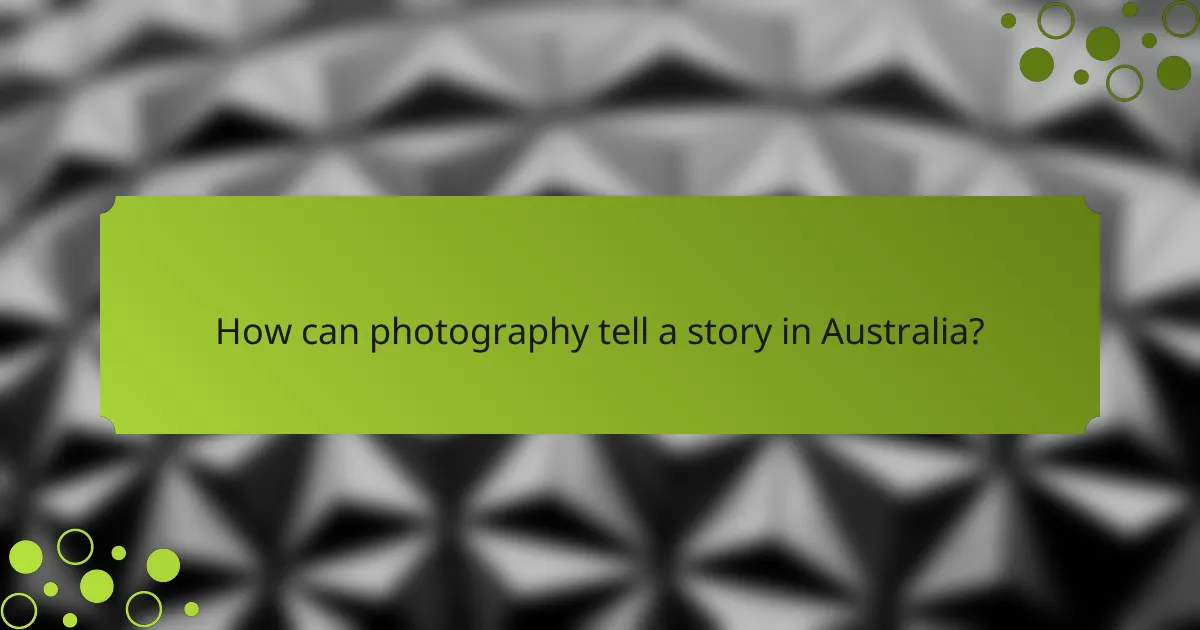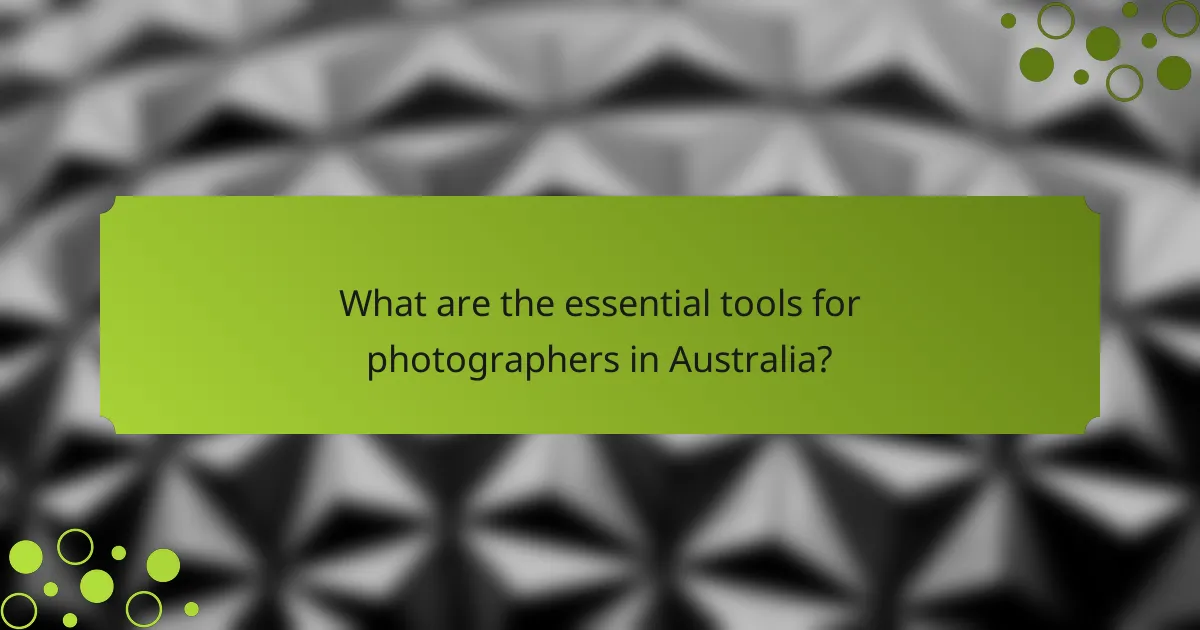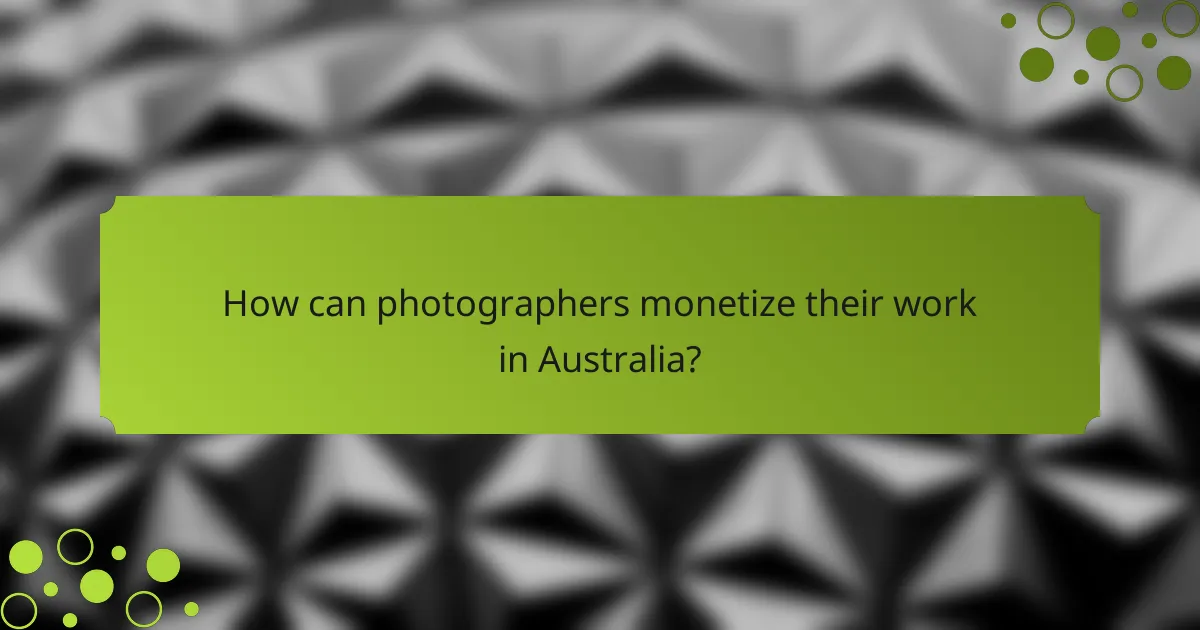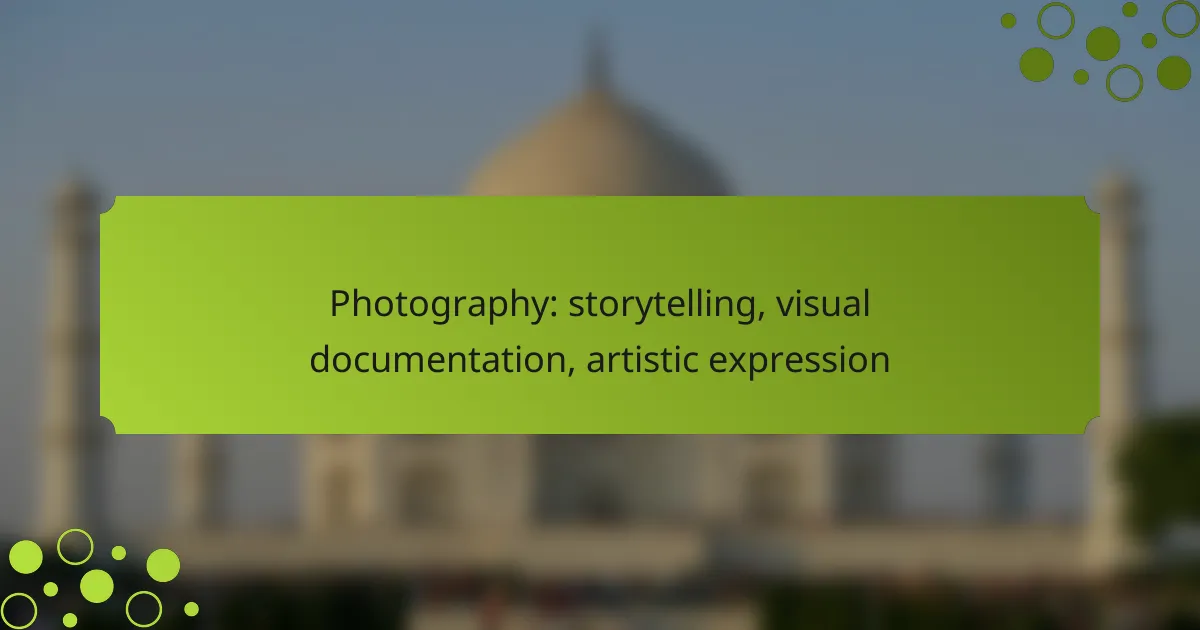Photography serves as a powerful medium for storytelling, allowing artists to capture the essence of diverse cultures and experiences. By mastering techniques such as composition and lighting, photographers can create compelling visual narratives that evoke emotions and document significant moments. This artistic expression not only reflects the photographer’s unique perspective but also invites viewers to engage with the stories behind each image.

How can photography tell a story in Australia?
Photography can effectively tell a story in Australia by capturing the unique landscapes, diverse cultures, and personal experiences of its people. Through visual narratives, photographers convey emotions, document events, and share the rich tapestry of life across the continent.
Emotional narratives through portraits
Portrait photography in Australia can evoke powerful emotions by highlighting the individuality of subjects. Capturing expressions, body language, and personal environments allows viewers to connect with the stories behind each face. For instance, photographing Indigenous Australians in their traditional settings can reveal deep cultural ties and personal histories.
To create compelling portraits, consider using natural light and candid moments that reflect genuine emotions. Avoid overly posed shots, as authenticity often resonates more with viewers. Engaging with your subjects beforehand can help build trust, resulting in more intimate and revealing images.
Documenting cultural events
Photography plays a crucial role in documenting cultural events across Australia, from festivals to ceremonies. These images preserve traditions and showcase the vibrancy of various communities, such as the Sydney Mardi Gras or local Indigenous ceremonies. Capturing these moments helps to educate others about cultural diversity and heritage.
When photographing events, be mindful of the context and significance of the occasion. Always seek permission when necessary, especially in Indigenous communities, to respect cultural protocols. Use a mix of wide shots to capture the atmosphere and close-ups to highlight individual emotions and interactions.
Visual storytelling in travel photography
Travel photography in Australia can narrate stories of exploration and adventure through stunning landscapes and urban scenes. By focusing on iconic locations like the Great Barrier Reef or the Outback, photographers can convey the essence of travel experiences. Including local people and their interactions with the environment adds depth to the narrative.
To enhance your travel photography, aim for a balance between iconic shots and unique perspectives. Experiment with different angles and times of day to capture the changing light and mood. Remember to include elements that reflect local culture, such as food markets or street art, to enrich your storytelling.

What are the best techniques for visual documentation?
The best techniques for visual documentation involve a combination of composition, lighting, and the ability to capture spontaneous moments. Mastering these elements can significantly enhance the storytelling aspect of photography, providing clarity and emotional depth to your images.
Using composition for impact
Effective composition is crucial for creating impactful visual documentation. Techniques such as the rule of thirds, leading lines, and framing can guide the viewer’s eye and emphasize the subject. For instance, placing the main subject off-center can create a more dynamic image.
Consider the background and foreground elements as well. A clutter-free background can help the subject stand out, while interesting foreground elements can add depth. Experimenting with different angles and perspectives can also yield surprising results.
Lighting techniques for clarity
Lighting plays a vital role in visual documentation, affecting mood and clarity. Natural light is often preferred for its soft quality, particularly during the golden hour—shortly after sunrise or before sunset. However, artificial lighting can be useful in low-light situations.
When using flash, consider the distance and angle to avoid harsh shadows. Diffusers can soften the light, creating a more flattering effect. Always be mindful of the color temperature; adjusting white balance settings can help maintain the natural look of your images.
Capturing candid moments
Capturing candid moments requires a keen eye and patience. Being unobtrusive allows you to photograph genuine emotions and interactions, which often tell a more compelling story. Use a longer focal length to maintain distance while still getting close-up shots.
To improve your chances of capturing these moments, anticipate actions and be ready to shoot at a moment’s notice. Continuous shooting mode can help you capture the perfect expression or gesture. Remember to blend into your surroundings to avoid disrupting the scene.

How does artistic expression manifest in photography?
Artistic expression in photography is revealed through the photographer’s unique perspective, creativity, and emotional engagement with their subject. This form of visual documentation allows individuals to convey stories, evoke feelings, and explore personal themes through their imagery.
Abstract photography styles
Abstract photography focuses on shapes, colors, and forms rather than recognizable subjects. This style encourages viewers to interpret images based on their emotions and perceptions, often leading to diverse interpretations. Techniques such as blurring, unusual angles, and selective focus can enhance the abstract quality of photographs.
Common abstract styles include minimalism, where simplicity reigns, and conceptual photography, which conveys ideas through visual metaphors. Photographers can experiment with light and shadow to create compelling compositions that challenge traditional views.
Incorporating personal themes
Incorporating personal themes in photography allows artists to express their identity, beliefs, and experiences. This can involve documenting personal milestones, cultural heritage, or social issues that resonate with the photographer. By sharing these themes, photographers create a deeper connection with their audience.
To effectively incorporate personal themes, photographers should reflect on their own stories and select subjects that resonate with their experiences. This approach can lead to powerful narratives that engage viewers on an emotional level.
Using color theory for mood
Color theory plays a crucial role in setting the mood and tone of a photograph. Different colors evoke specific emotions; for instance, warm colors like red and orange can create feelings of warmth and excitement, while cool colors like blue and green often convey calmness and tranquility. Understanding these associations can enhance the artistic expression in photography.
When planning a shoot, consider the emotional response you want to elicit from viewers. Use color palettes strategically to reinforce your theme. For example, a monochromatic scheme can create a sense of harmony, while contrasting colors can generate tension and interest.

What are the essential tools for photographers in Australia?
Photographers in Australia need a combination of high-quality cameras, versatile lenses, and effective editing software to create compelling visual stories. These tools enhance their ability to capture moments and express artistic visions while adapting to various environments and lighting conditions.
Best cameras for storytelling
When selecting a camera for storytelling, consider models that offer excellent image quality and performance in diverse settings. Popular choices among Australian photographers include full-frame DSLRs and mirrorless cameras, such as the Canon EOS R5 and Sony A7 III, which excel in low-light conditions and dynamic scenes.
Look for features like fast autofocus, high frame rates, and robust video capabilities, as these can significantly enhance your storytelling potential. Additionally, ensure the camera has good weather sealing if you plan to shoot outdoors in varying Australian climates.
Must-have lenses for versatility
Versatile lenses are crucial for capturing a range of subjects and scenes. A standard zoom lens, such as a 24-70mm f/2.8, is ideal for general photography, allowing you to shoot landscapes, portraits, and events with ease. For more specialized needs, consider a wide-angle lens for expansive landscapes or a telephoto lens for wildlife photography.
In Australia, a macro lens can also be beneficial for capturing the intricate details of local flora and fauna. Always assess your shooting style and the environments you frequent to choose lenses that best suit your needs.
Editing software for artistic expression
Editing software is essential for refining your images and expressing your artistic vision. Adobe Lightroom and Photoshop are industry standards that offer powerful tools for color correction, retouching, and creative enhancements. These programs allow you to manipulate images to convey the story you want to tell.
For those seeking alternatives, consider Capture One or Affinity Photo, which also provide robust editing capabilities. Familiarize yourself with the software’s features and workflows to maximize your efficiency and creativity during the editing process.

What criteria should photographers consider for selecting subjects?
Photographers should consider the relevance of their subjects to their audience, as well as the emotional connection they can establish with those subjects. These criteria help ensure that the photographs resonate and communicate effectively, enhancing the storytelling aspect of the images.
Relevance to audience interests
Understanding what interests your audience is crucial when selecting subjects. Research trends in photography and popular themes that engage viewers, such as nature, urban life, or cultural events. Tailoring your subject choice to these interests can significantly increase the impact of your work.
Consider creating a list of potential subjects based on audience demographics. For example, if your audience is primarily young adults, subjects like street art or music festivals may resonate more than traditional landscapes. Regularly engaging with your audience through social media or surveys can provide valuable insights into their preferences.
Emotional connection with subjects
Establishing an emotional connection with your subjects can elevate your photography from mere documentation to powerful storytelling. Choose subjects that evoke feelings, whether it’s joy, nostalgia, or contemplation. This connection can be achieved through candid moments, expressive portraits, or intimate settings.
When selecting subjects, think about how they relate to universal human experiences. For instance, capturing a child’s laughter or an elderly person’s wisdom can create relatable and impactful images. Aim for authenticity in your work, as genuine emotions often resonate more deeply with viewers.

How can photographers monetize their work in Australia?
Photographers in Australia can monetize their work through various avenues, including selling prints, licensing images on stock platforms, and offering freelance services for events. Each method has its own benefits and considerations, allowing photographers to choose what aligns best with their skills and market demand.
Print sales and exhibitions
Print sales and exhibitions provide photographers with a direct way to sell their work to the public. Setting up an exhibition can involve renting a gallery space, which may cost several hundred to thousands of Australian dollars, depending on the location and duration.
To maximize sales, consider offering a range of print sizes and formats, such as framed prints or canvas wraps. Promoting your exhibition through social media and local art communities can also attract more visitors and potential buyers.
Stock photography platforms
Stock photography platforms allow photographers to upload their images for licensing, earning money each time someone purchases a license to use their work. Popular platforms in Australia include Shutterstock, Adobe Stock, and Getty Images.
When using stock platforms, focus on high-demand niches like travel, lifestyle, and business imagery. Keep in mind that commission rates can vary, typically ranging from 15% to 50%, so it’s wise to read the terms carefully before committing your work.
Freelance opportunities in events
Freelancing for events is a lucrative option for photographers, as it includes weddings, corporate functions, and private parties. Rates for event photography in Australia can range from AUD 1,000 to AUD 3,000 or more, depending on the event’s scale and the photographer’s experience.
To secure freelance gigs, build a strong portfolio showcasing your best work and network within your community. Consider joining local event planning groups or online platforms that connect photographers with clients seeking event services.
